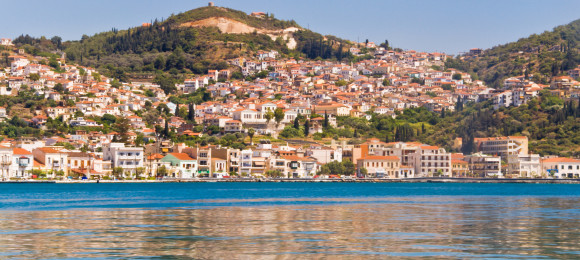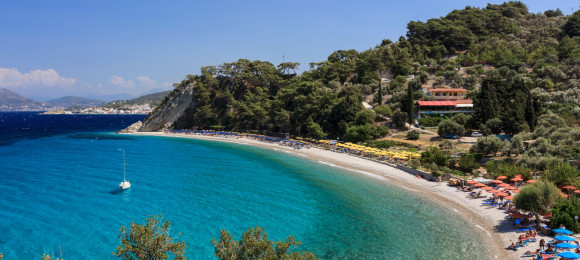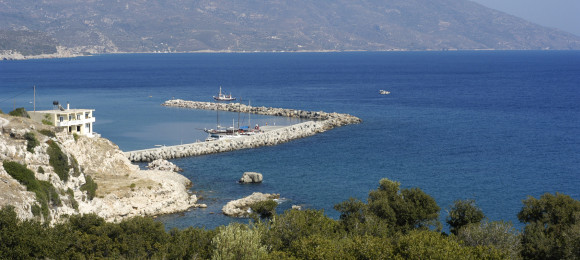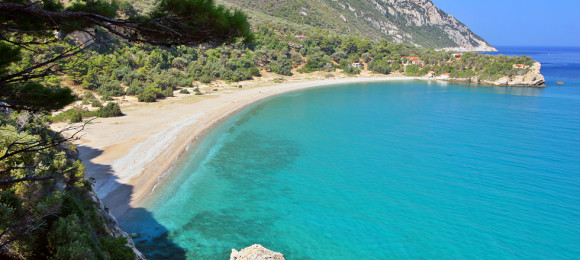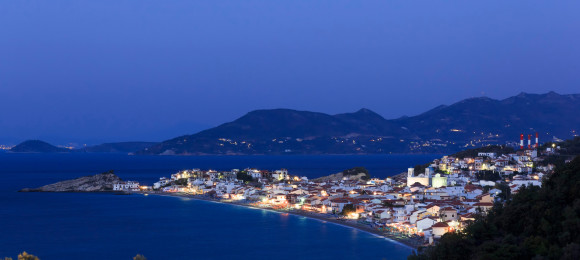Overview of Samos
Samos has it all – it’s no exaggeration. This explains its popularity among different types of visitors: from package tourists to independent travelers, families, couples, young, old and so on. Samos features some of the most outstanding ancient sites found in the Greek islands – in antiquity it was an important maritime centre, as well as the birthplace of goddess Hera and scientists/philosophers Pythagoras, Epicurus and Aristarchus. It also has many fascinating landscape variations: it’s one of the greenest Greek islands, fertile, mountainous, with canyons, waterfalls, caves, wetlands, plains, touristic and isolated regions and of course beaches of immense beauty.
Samos is quite large, situated at the Northeast Aegean, close to Turkey. It has three ports and consists of four municipalities: the capital and main port of Vathy (or Samos), Karlovasi, Pythagorio and Marathokambos. Vathy is a scenic hilly settlement with neoclassical mansions, red-roof houses, a pedestrianized agora, a busy waterfront, many facilities, as well as the traditional old district of Ano Vathy. Pythagorio, built on the ruins of ancient Samos, is perhaps the island’s most developed and popular resort, mainly thanks to its proximity to the antiquities (Ireon, Efpalinio Orygma, etc).
Northern Karlovasi is the island’s economic centre: a modern touristic town formed by the unification of four settlements (Palio/old, Mesaio/middle, Neo/new Karlovasi and Ormos/port). On the other hand, Marathokambos is very traditional, facing the bay of the same name and offering sights such as nearby beaches, monasteries and the famed Cave of Pythagoras. The rest of the island’s villages –both inland and coastal- evoke unforgettable images: Picturesque fishing ports, mountainous settlements, kafenia and squares, rare architecture and superb views. Accompany your journey to Samos with its famous sweet wine: this Greek island is bound to surprise you with its many charming faces.
Photo gallery of Samos
Beaches Food Things to see & do
Kerveli
: Situated in a small bay, this beautiful pebbly beach with emerald shallow waters offers the natural shadow of trees and tranquil moments by the sea. The only amenities here are a few tavernas.Potami
: Close to Karlovasi, this impressive pebbly beach (not organized) is located at the mouth of a river that flows into the sea. Not to miss: Walk by the river upstream, cross a lovely forest and swim into a small lake until you reach the well-known waterfalls of the area.Mikro (small) and Megalo (large) Seitani
: Accessed only either by boat or walking, but absolutely rewarding. These two neighboring pebbly beaches are isolated (so bring supplies) and nudist friendly. They also provide shelter for monk seals.Tsamadou
: One of the prettiest pebbly beaches on the island, surrounded by pine trees. It is preferred by nudists and features crystalline blue waters and the basic facilities. As all northern beaches, it can get windy.Votsalakia (Kambos)
: Long, pebbly and organized beach, with deep clean waters. Tavernas and cafes are available here.Psili Ammos
: Being the closest to Asia Minor coast, this beach (one of the few sandy on the island) is fully organized, quiet, with shallow waters.Irodion Garden Restaurant
: Pythagorio, Greek cuisine.To Aperanto – Taverna Endless
: Mykali, Greek cuisine.Randezvous 2000
: Karlovasi, Greek cuisine.The Ballad of Bill & Salome
: Votsalakia, Greek cuisine.Stella
: Koumeika, Greek cuisine.Meltemi
: Kokkari, Greek cuisine.Ireon
: One of the top Greek island attractions and also a UNESCO World Heritage site. It is situated in the coastal settlement of the same name, at the mouth of river Imvrassos, where goddess Hera was born. This majestic sanctuary, dedicated to her, is believed to have been the largest one in antiquity. Among the remains of the complex, you can see the temple of Hera, smaller temples, altars, stoas, a 5th c Christian basilica and the Sacred Way that led to Samos’ ancient capital (now the town of Pythagorio).Village hopping in Samos
: Village hopping in Samos: They are indeed so many villages on the island. Note down the following suggestions - At the north: Kokkari, Vourliotes, Manolates, Kontakeika, Konteika. Southeast: Mykali, Chora, Mytilinii. Southwest: Pagondas, Koumaradei, Pyrgos, Koumeika, Kallithea, Drakei.Archaeological Museums of Samos and Pythagorio
: They host prominent findings of the island’s ancient sites and are definitely worth visiting. The Archaeological Museum of Samos (located at Vathy) is considered as one of the best in the Greek islands and features a colossal 5.5m kouros statue, among other exhibits. The Archaeological Museum of Pythagorio unfolds Samos’ history from Prehistoric to Byzantine times.Efpalinio Orygma/Tunel
: Close to Pythagorio, this is another top sight of Samos and one of the most important ancient technical achievements (also called “the eighth wonder”). It is a 6th c BC tunnel of 1036 m. that penetrates Mt Kastro, constructed by the ingenious engineer Efpalinos. It was used as an aqueduct to ensure water supply for the densely populated ancient city of Samos. A part of it is accessible to visitors. Also note that at the ridge of Mt Kastro lay the remains of the Wall of Polycrates (the ancient city’s fortifications).Daily boat excursions
: To the tranquil islet of Samiopoula at the south of Samos, but also to the nearby island of Ikaria and the small island complex of Fourni.Local products
: Samos is famous for its high quality, internationally acknowledged wine (the island has a long tradition in wine making since antiquity). Oil and honey are also excellent, as well as ouzo, cheese and fish. Last but not least, the island’s ceramics are also well-known (remember the famous Pythagorian cup: you fill it up to a certain level, but if you exceed that, it empties at once).For nature lovers
: Explore the two mountains of Samos (rocky Kerkis and verdant Ambelos/Karvounis). Furthermore, the wetlands of Alyki, Mesokambos (a swamp) and Glyfades (lakes) provide shelter for migratory birds and other animal species.Churches & monasteries
: They are numerous and well-known for their historical, architectural and religious importance. Panagia Vrontiani is the oldest monastery on Samos, built among lush vegetation and famous for its icons and frescoes, with views towards the coast of Asia Minor. Megali Panagia, founded in 1586, offers fascinating views and frescoes, while it’s also known for its great contribution to the Greek Revolution. Panagia Spiliani is a small church built inside a large cave that features the miraculous icon of Virgin Mary. It is also believed to have hosted the philosophical school of Pythagoras.Join the festival
: The island’s Wine Festival, the Ireon Music Festival (youngsters’ favorite) and the Manolis Kalomoiris Festival are the most popular summer cultural attractions.Join the feast
: The feast of fishermen in June and the anniversary of the battle in Mykali on August 6th (both held in Pythagorio). Also, the local custom of “Giorti” (eng “feast”) dedicated to the Virgin Mary: on the night of August 22nd, goat meat with onions and wheat is cooked in huge coppers and served the next day.Map of Samos
Reviews of Samos
Melania said:


